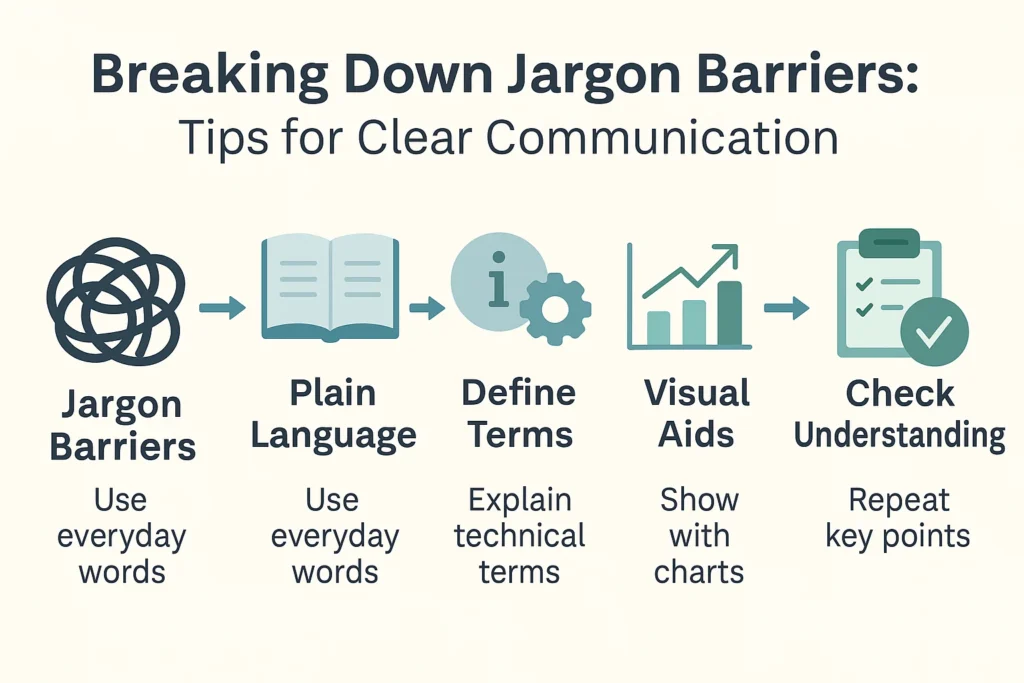Jargon Barriers to Communication
Clear communication is the backbone of every successful interaction. Still, jargon barriers to communication remain a silent obstacle in workplaces, healthcare, customer service, and everyday life. You may have heard a professional toss around terms you didn’t understand or read an instruction manual that made your head spin. These situations are common—and they don’t just cause confusion. Jargon barriers to communication lower trust, limit access, and can even lead to costly mistakes. The good news is, you can spot these obstacles and learn strategies to make every message clear.
What Are Jargon Barriers to Communication?
Jargon barriers to communication arise when people use specialized words, phrases, or abbreviations that are hard for outsiders to understand. While jargon can help experts share details quickly, it also creates invisible walls that exclude others. Medical, legal, and tech fields are notorious for this, but jargon pops up in nearly every industry and community.
Consider a doctor discussing “hypertension” and “bilateral edema” with a patient, or an IT specialist telling you to “clear your DNS cache.” For many, these words are more confusing than helpful. The Plain Language Action and Information Network says the best communication uses simple words so everyone gets the message the first time.
Why Jargon Barriers Matter
Jargon barriers to communication don’t just make people feel left out—they can have real, negative impacts. When a message is buried in complicated language, people miss important information. In healthcare, this could mean not understanding how to take medicine correctly. At work, it might cause delays, errors, or missed deadlines. In legal settings, unclear contracts can even spark disputes or lawsuits.
Health Literacy and Accessibility
Jargon especially hurts people with limited health literacy, non-native speakers, or cognitive disabilities. The Centers for Disease Control and Prevention stresses that plain language makes health information easier to access and understand, which is vital for everyone’s well-being.
Cognitive Load
The brain can only handle so much new information at once. When you load a message with unfamiliar jargon, you raise the “cognitive load” and make it harder for people to follow along. This leads to frustration and mistakes, even among experienced professionals.
Common Types of Jargon That Cause Barriers
Industry-Specific Language
Every profession develops its own set of specialized terms. In healthcare, you’ll hear words like “EHR,” “prognosis,” or “phlebotomy.” Finance professionals talk about “amortization,” “liquidity,” and “ROI.” Marketing teams drop terms like “CTR,” “lead funnel,” or “conversion rate,” while lawyers might refer to “affidavit,” “tort,” or “indemnity.” These expressions are familiar to people inside those industries, but for everyone else, they often sound puzzling or are easily misunderstood.
Acronyms and Abbreviations
Shortened forms like “API,” “HR,” “HIPAA,” or “UX” might seem like time-savers. But when these aren’t spelled out or explained, they can quickly lose meaning for people outside the field.
Technical Terminology
Specialized instructions such as “adjust the torque,” “rebase the branch,” or “phishing attack” can make otherwise simple tasks seem daunting, especially for those without a technical background.
Slang, Shorthand, and Buzzwords
Trendy phrases and buzzwords—including “pivot,” “scalability,” or “low-hanging fruit”—pop up in meetings and emails all the time. However, these can confuse or exclude those who aren’t familiar with them. Using too much insider slang can make outsiders feel left out of the conversation.
Cross-Cultural and Multilingual Challenges
Jargon barriers to communication don’t just affect English speakers. A word or phrase that’s clear in one language or culture might be completely confusing—or even inappropriate—in another. It’s important to remember that these barriers can cross both language and cultural lines.
Who Is Most Affected By Jargon Barriers?
Anyone can be affected, but some groups face more hurdles:
- New employees or team members
- Non-native speakers or people from different backgrounds
- Patients, customers, or clients outside the field
- Older adults or children
- People with disabilities (cognitive, reading, or learning differences)
Universal design for communication means aiming for clarity so everyone—regardless of background or ability—can participate.
Where Do Jargon Barriers Show Up?
Healthcare
Patients with low health literacy may not follow instructions if they’re filled with medical jargon. This can lead to dangerous mistakes or missed treatments. Research shows that clear communication in healthcare improves outcomes, safety, and patient satisfaction.
Customer Service
Ever called tech support and gotten lost in a sea of terms like “firmware,” “cookies,” or “back-end integration”? Jargon can leave customers feeling lost and dissatisfied, hurting a company’s reputation.
Remote Work and Digital Meetings
In online meetings, email threads, or chat apps, body language and tone are missing—so unclear words or abbreviations make things even worse.
Contracts and Legal Documents
Unexplained legal terms can lead to costly misunderstandings or even lawsuits. In legal settings, jargon is a risk, not just a nuisance.
Marketing and Branding
Overly technical or trendy language in websites, ads, or sales pitches can scare away potential clients or customers.
Emergency and Crisis Communication
In a crisis, people need clear instructions fast. Jargon can cost precious time and even lives in emergencies.
Why Do People Use Jargon?
People don’t use jargon to confuse others on purpose. Usually, it’s a habit formed in training or on the job. It can also be a way to show expertise, signal group belonging, or save time in specialist conversations. Sometimes, people simply forget that not everyone shares their background or training.
Audience analysis—thinking about who will receive your message—can help avoid this trap.
The True Cost of Miscommunication
Jargon barriers to communication have real-world costs:
- Lost sales or clients: Customers who don’t understand leave for a competitor.
- Reduced productivity: Employees waste time decoding messages.
- Medical errors: Patients misunderstand instructions.
- Legal disputes: Ambiguity in contracts leads to conflict.
- Lowered trust: People feel excluded or looked down on.
How to Overcome Jargon Barriers

Use Plain Language
Replace technical terms with simple words whenever possible. Instead of “utilize,” say “use.” Instead of “amortization,” say “how you pay back a loan.” The PlainLanguage.gov Guidelines offer practical tips.
Define and Explain Terms
If a technical word or acronym must be used, define it right away. “Our EHR (electronic health record) system tracks your medical history.” Or, add a quick glossary at the end.
Visual Aids and Accessibility
Use charts, diagrams, icons, and other visuals to clarify ideas. Visuals cross language and literacy barriers and lower cognitive load.
Check for Understanding
Ask open questions: “Does this make sense?” or “Would you like me to explain that?” Encourage feedback and make it safe for people to say they’re confused.
Glossary Creation
For documents, presentations, or websites, include a glossary of terms. This gives readers a quick way to look up unfamiliar words.
Policy and Training
Organizations should create style guides, offer communication training, and encourage staff to check for clarity. Language simplification tools like Hemingway Editor or built-in readability checks in word processors are easy ways to improve plain language.
Universal Design for Communication
Design every message to be understood by the widest possible audience. This means considering age, background, ability, and language.
Jargon vs. Plain Language
| Jargon | Plain Language |
|---|---|
| Facilitate synergy | Work together |
| Amortization schedule | Loan payment plan |
| Prognosis is guarded | The outcome is uncertain |
| Achieve scalability | Grow easily |
| API integration | Programs working together |
| EHR | Electronic health record |
| ROI | Return on investment |
| Phlebotomy | Taking a blood sample |
Conclusion
Jargon barriers to communication don’t just cause frustration—they can damage relationships, lower performance, and even put people at risk. The goal is always understanding. If you choose plain language, define terms, and check for clarity, you’ll connect better with colleagues, customers, and the community. Remember: jargon barriers to communication are easy to miss, but with small changes, you can make every message clear, helpful, and inclusive.
FAQs
Ask for an explanation. You’re helping others learn to communicate more clearly.






